Painting is a creatively fulfilling hobby that offers relaxation and self-expression. It allows you to explore your artistic side, learn new techniques, and enjoy the therapeutic benefits of creating art. With the right guide, anyone can begin their painting journey, whether it’s for personal enjoyment or as a professional pursuit. Discover how painting can transform your free time into a rewarding and inspiring experience.
1.1. Why Painting is a Great Hobby
Painting is a wonderfully relaxing and creative outlet that offers numerous benefits. It allows for self-expression, fosters mindfulness, and provides a sense of accomplishment. Whether you’re aiming to unwind or explore your artistic side, painting is an accessible hobby for everyone. It sparks creativity, enhances problem-solving skills, and can even serve as a therapeutic activity. Painting also offers a rewarding way to transform spaces or create personalized art, making it a fulfilling and enjoyable pastime for people of all ages and skill levels.
1.2. Getting Started with Painting
Getting started with painting is simple and rewarding. Begin by selecting the right paint type for your project, such as acrylic, oil, or watercolor. Gather essential tools like brushes, a palette, and canvas or painting surface. Set up a well-ventilated workspace and prepare your surface with cleaning and priming if needed. Start with small projects or practice exercises to build confidence. Resources like Sherwin-Williams offer helpful guides to ensure a smooth and enjoyable experience for beginners.
1.3. Tips for Beginners
Start with simple projects and gradually experiment with more complex techniques. Work from reference images to help guide your composition. Choose a small canvas and a basic palette of paints to keep things manageable. Invest in essential supplies like quality brushes and a sturdy palette. Practice blending colors and layering to achieve smooth results. Don’t be afraid to make mistakes—they’re part of the learning process. Regular practice will help refine your skills and build confidence in your artistic abilities.

Choosing the Right Paint and Tools
Selecting the right paint and tools is crucial for achieving professional results. Explore various types of paint and essential tools to enhance your painting experience and creativity.
2.1. Types of Paint: Acrylic, Oil, and Watercolor
Acrylic, oil, and watercolor paints are popular choices for different artistic needs. Acrylic paint is versatile, fast-drying, and ideal for bold, textured works. Oil paint offers rich colors and blending capabilities, perfect for detailed, realistic pieces. Watercolor paint is translucent and fluid, great for delicate, ethereal designs. Each type suits specific techniques and artistic styles, allowing artists to choose the best medium for their creative vision and project requirements.
2.2. Essential Painting Tools: Brushes, Palette, and Canvas
Your painting journey starts with the right tools. Brushes are available in natural or synthetic fibers, each suited for specific techniques and paint types. A palette provides a space for mixing colors, available in disposable or reusable options. The canvas is your painting surface, offered in various textures and sizes. These essentials ensure you’re well-equipped to create stunning artwork, whether you’re working with acrylics, oils, or watercolors. Quality tools enhance your artistic process and final results.
2.3. Understanding Paint Finishes and Sheens
Paint finishes and sheens determine the appearance and durability of your work. Options include flat, eggshell, satin, semi-gloss, and high-gloss. Flat finishes hide imperfections but lack durability, while high-gloss offers maximum shine and resilience. Eggshell and satin provide a balanced look, ideal for most interiors. Understanding these finishes helps you choose the right one for your project, ensuring both aesthetic appeal and long-lasting results. This guide will help you select the perfect finish for your painting needs.

Preparing for Your Paint Project
Proper preparation ensures a smooth and professional paint job. Clean surfaces thoroughly, fix cracks, and prime if needed. Protect surroundings with tape and drop cloths for precise results.
3.1. Surface Preparation: Cleaning and Priming
Surface preparation is crucial for a successful paint job. Start by cleaning the area thoroughly to remove dirt, grease, or mildew. Use a mixture of soap and water or a specialized cleaner. Rinse and let it dry completely. Next, assess if priming is needed. Bare wood, stained surfaces, or dark colors often require a primer to ensure better paint adhesion and coverage. Apply primer evenly and allow it to dry as per instructions before proceeding to paint.
3.2. How to Tape and Protect Surroundings
Protecting surrounding areas is essential for a neat paint job. Apply high-quality painter’s tape carefully along edges, trim, and moldings. Press the tape firmly to ensure it adheres properly. Use drop cloths or plastic sheets to cover floors, furniture, and fixtures. For intricate areas, consider using specialized tools like paint shields or straightedges. Remove tape immediately after painting to avoid paint pulling off with the tape. This step ensures crisp, clean lines and protects surfaces from unwanted paint splatters.
3.3. Repairing Walls Before Painting
Before painting, ensure walls are smooth and damage-free. Clean surfaces thoroughly to remove dirt or grease. Fill holes or cracks with spackling compound, let dry, then sand until smooth. For larger damage, apply joint compound and sand until flush with the wall. Wipe away dust with a damp cloth. If necessary, prime repaired areas to ensure even paint adhesion. Addressing these issues first guarantees a professional-looking finish and prevents imperfections from showing through the paint.
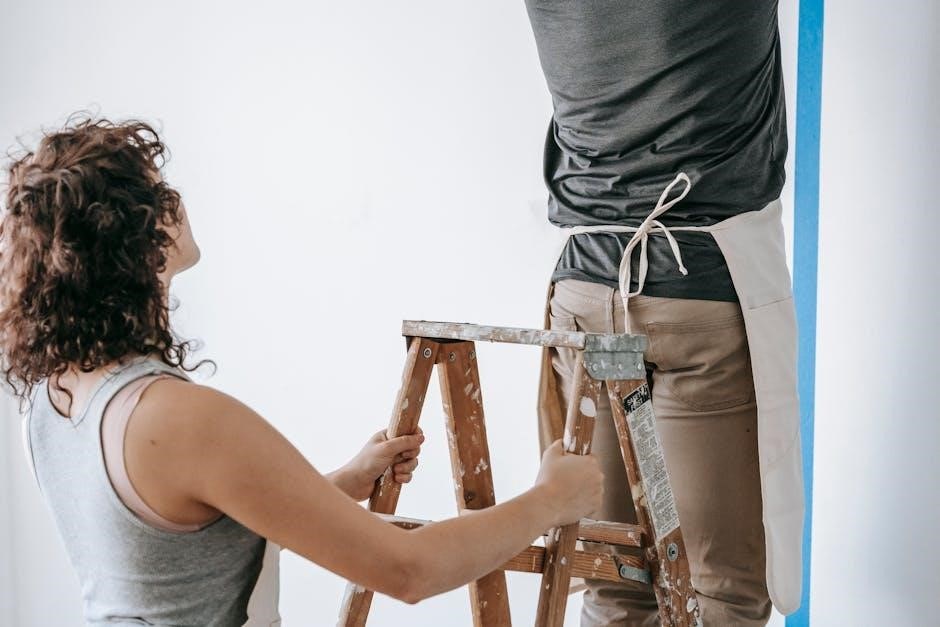
Painting Techniques and Application
Master essential painting techniques for smooth, professional results. Learn proper brushstrokes, layering, and blending to achieve desired effects. Explore tools and materials for flawless application and finish.
4.1. Basic Painting Techniques for Smooth Results
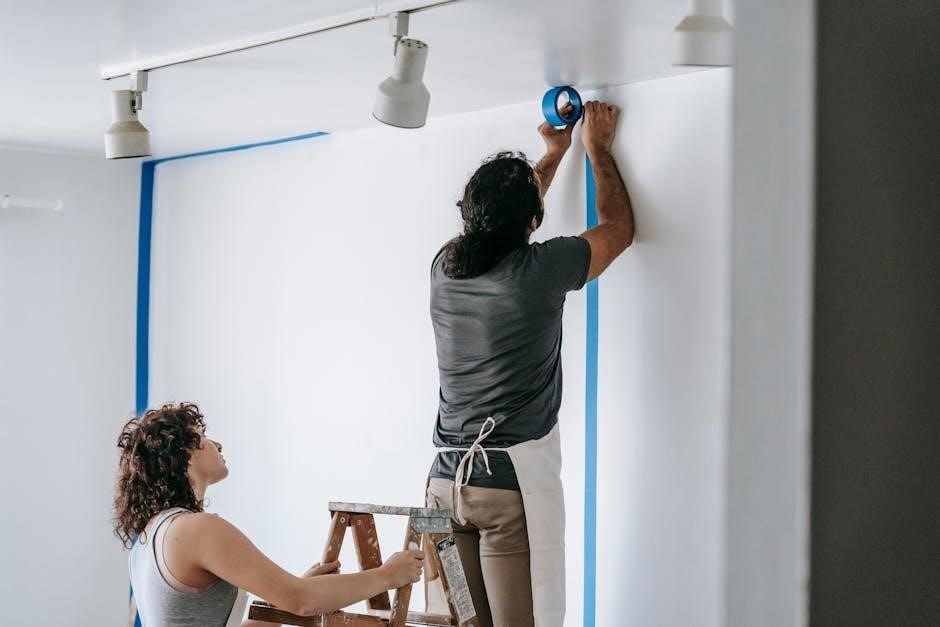
Mastering basic painting techniques ensures a smooth, professional finish. Start with proper surface preparation and apply thin, even coats. Use high-quality brushes and work in small sections to maintain control. Practice strokes like flatting and blending for uniform coverage. Allow each layer to dry before adding more paint. These foundational methods build a solid base for more complex techniques, helping you achieve consistent, polished results in your painting projects.
4.2. Advanced Methods: Layering and Blending
Layering and blending are advanced techniques that add depth and dimension to your painting. Start by applying thin layers of paint, allowing each to dry before adding the next. This builds richness and prevents muddying colors. For blending, use a wet-on-wet approach, merging colors while still damp. Practice these methods to achieve smooth transitions and intricate details. Experimenting with tools like sponges or airbrushes can further enhance your results, making your work more dynamic and visually striking.
4.3. Achieving Straight Lines and Sharp Edges
Achieving straight lines and sharp edges requires precision and the right tools. Use painter’s tape to mask off areas, ensuring it’s pressed firmly for a seal. Apply paint in smooth, even strokes, and remove tape immediately after painting. For crisp edges, use a sealant or flexible painting shield. Tools like straightedges or paint guides can also help. Practice these techniques to create professional-looking results with clean, defined lines that elevate your painting project to the next level.

Finishing Touches and Cleanup
Finishing touches involve allowing paint to dry, removing tape carefully, and touching up mistakes. Clean tools and workspace thoroughly for a polished result.
5.1. Allowing Paint to Dry Properly
Proper drying is crucial for a flawless finish. Allow paint to dry according to the manufacturer’s instructions, usually between 30 minutes to several hours. Ensure good ventilation and avoid humidity. Lightly touching the surface can help determine dryness. For optimal results, let the first coat dry before applying a second. Patience ensures durability and prevents peeling or unevenness, achieving a professional-quality finish.
5.2. Removing Tape and Touching Up Mistakes
After painting, remove tape carefully to avoid pulling off the paint. Inspect for any mistakes or areas where paint may have seeped under the tape. For touch-ups, lightly sand the area and repaint. Use a small brush to blend the repaired section with the surrounding paint. Clean tools with soap and water after use. Patience and attention to detail ensure a polished finish, making your paint job look professional and flawless.
5.3. Cleaning Your Tools and Workspace
Properly cleaning your tools and workspace after painting ensures longevity and prevents paint buildup; Wash brushes with soap and warm water, or use solvents for oil-based paints. Clean rollers by scraping off excess paint and washing with water. Wipe down surfaces with damp cloths to remove spills. Store tools in a dry, protected area to maintain their quality. A clean workspace also helps prevent accidents and makes future painting projects easier to start.
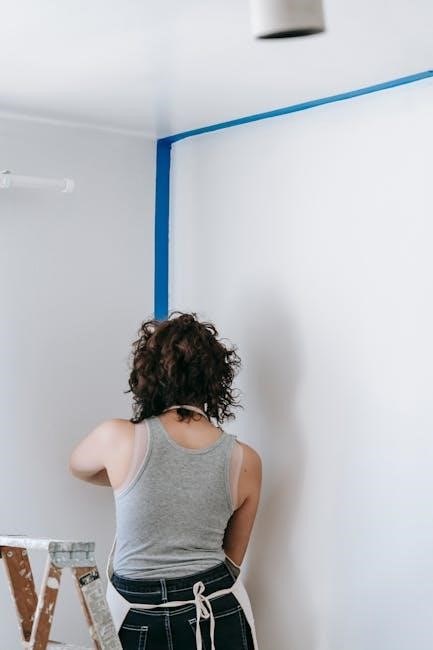
Color Selection and Coordination
Selecting the right colors enhances the visual appeal of your space. Consider the room’s purpose, lighting, and personal preferences when choosing hues. Use color psychology to evoke desired moods, ensuring harmony and balance in your design. A well-coordinated palette can transform any area, making it inviting and aesthetically pleasing. Explore various color schemes to find the perfect fit for your project.
6.1. How to Choose the Perfect Paint Color
Choosing the perfect paint color involves considering the room’s purpose, lighting, and your personal style. Start by using a color wheel to identify complementary hues. Test samples on walls to see how they look at different times of day. Consider the psychological impact of colors—cool tones for calmness, warm tones for energy. Use paint swatches or apps to visualize the final result. Don’t forget to think about the finish, as it affects the color’s appearance. This step-by-step approach ensures a harmonious and satisfying outcome.
6.2. Understanding Color Psychology in Painting
Color psychology plays a crucial role in painting, as different hues evoke distinct emotions and moods. Cool tones like blues and greens create calmness and serenity, while warm tones such as reds and oranges energize and inspire. Neutrals like beige and gray offer balance and sophistication. Understanding this allows you to select colors that align with the desired atmosphere of a space, creating a visually and emotionally harmonious environment that reflects your vision and enhances well-being.
6.3. Creating a Harmonious Color Scheme
A harmonious color scheme enhances the visual appeal of your painting project. Start by selecting a base color, then add complementary or analogous hues for balance. The 60-30-10 rule is a great guide: 60% dominant color, 30% secondary, and 10% accent. Consider the natural light and mood you want to create. Test samples on the wall to ensure colors work well together. This approach helps you craft a cohesive and visually pleasing palette for any space, making your painting project a success.
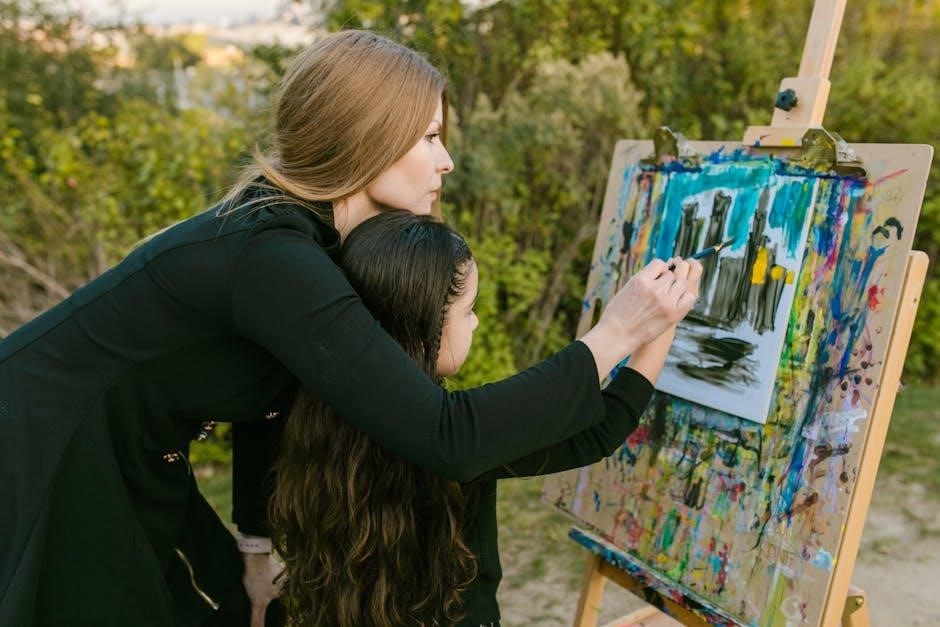
Maintenance and Touch-Ups
Regular inspections and quick fixes keep your paint job fresh. Clean tools, store leftover paint properly, and touch up minor scratches or fading to maintain a polished look.
7.1. Keeping Your Paint Job Looking Fresh
To maintain a fresh appearance, inspect painted surfaces regularly for signs of wear or damage. Clean surfaces with mild soap and water to remove dirt and grime. Address minor scratches or fading promptly to prevent further deterioration. Proper storage of leftover paint ensures it remains usable for future touch-ups; Regular maintenance not only extends the life of your paint job but also keeps your space looking vibrant and well-cared-for. Consistency is key to preserving a professional finish.
7.2. How to Store Leftover Paint
Properly storing leftover paint ensures its longevity and usability for future projects. Always keep paint in a tightly sealed, airtight container to prevent drying out. Label the container with the paint type, color, and date for easy identification. Store in a cool, dry place away from direct sunlight and heat sources. Check expiration dates and discard expired paint responsibly. This method preserves paint quality and keeps your workspace organized, ready for the next project. Proper storage also prevents waste and saves money. Always keep paint out of reach of children and pets.
7.3. Fixing Scratches and Fading Over Time
To address scratches and fading, start by lightly sanding the affected area to smooth the surface. Apply a touch-up paint that matches the original color, using a small brush for precision. For deeper scratches, consider a primer first. Once dry, seal with a clear coat to protect the repair. Regular maintenance, such as cleaning and inspecting painted surfaces, can prevent further damage. Addressing issues early ensures your paint job remains vibrant and intact over time, maintaining its professional appearance.

Specialized Painting Techniques
Specialized painting techniques like faux finishes, airbrushing, and stencils add unique effects to your projects. These methods offer precision and creativity for distinctive, professional-looking results, transforming any surface with versatility.
8.1. Faux Finishes: Adding Texture and Depth
Faux finishes are techniques that mimic materials like marble, wood, or stone, adding texture and depth to surfaces. These methods involve layering paint and glazes to create realistic effects. From subtle textures to elaborate designs, faux finishes offer a creative way to enhance walls, furniture, and other objects. They are ideal for those seeking unique, high-end looks without the cost of actual materials. With practice, anyone can master these artistic techniques to elevate their painting projects.
8.2. Airbrushing for Smooth, Even Coverage
Airbrushing is a versatile technique offering smooth, even coverage for detailed work. It’s ideal for models, vehicles, and fine art, allowing precise control over paint application. With practice, airbrushing enables seamless blending and uniform finishes. Proper setup and thinning of paint are key to achieving professional results. Whether for small-scale projects or large surfaces, airbrushing adds a touch of professionalism to your work. Explore guides and tutorials to master this skill and elevate your painting projects to new levels of precision and artistry.
8.3. Using Stencils for Precise Designs
Stencils are a fantastic tool for achieving precise, intricate designs in your painting projects. They allow for crisp, sharp edges and consistent patterns, making them ideal for creating detailed motifs or lettering. Suitable for various surfaces, stencils are perfect for wall art, furniture decoration, or crafting unique designs. Pair them with airbrushing or traditional brushes for stunning results. Whether you’re aiming for geometric patterns or custom text, stencils offer a versatile and efficient way to add personality to your work with minimal effort and maximum precision.
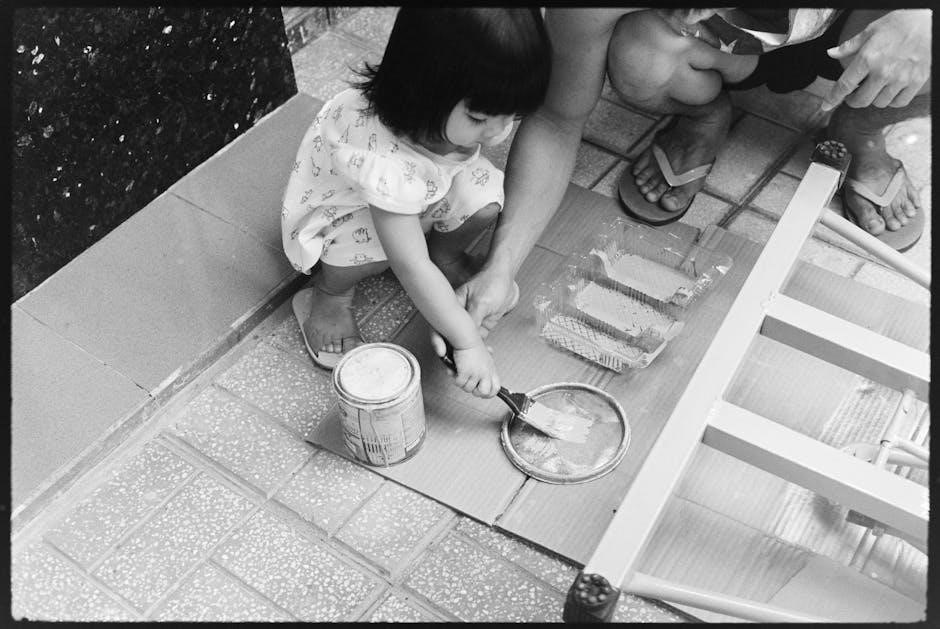
Painting Trends and Inspiration
Discover the latest trends in painting, from abstract minimalism to nature-inspired themes. Find inspiration in color palettes, seasonal motifs, and creative techniques to spark your next project.
9.1. Popular Painting Styles for Beginners
For beginners, popular painting styles include abstract art, watercolor landscapes, and acrylic minimalism. These styles emphasize creativity and simplicity, making them ideal for those new to painting. Abstract art allows for expressive freedom, while watercolor and acrylic techniques offer forgiving mediums to practice. Seasonal and themed painting ideas, such as holiday-themed canvases or nature-inspired motifs, also provide inspiration. These styles are great for building confidence and skill, helping you find your artistic voice while exploring different creative avenues.
9.2. Finding Inspiration for Your Next Project
Finding inspiration for your next painting project can come from various sources. Explore color trends, nature, or even personal experiences. Websites like Sherwin-Williams and Pinterest offer vibrant color palettes and creative ideas. Design blogs and social media platforms showcase trending styles and techniques. Visit local art galleries or museums to spark creativity. Additionally, seasonal themes and holiday decorations can provide unique motifs. Let your surroundings and emotions guide your brush, turning everyday moments into artistic expressions.
9.3. Seasonal and Themed Painting Ideas
Seasonal and themed painting ideas can inspire creativity and add personal flair to your projects. For holidays, try painting Christmas ornaments, Easter eggs, or Halloween-themed murals. Spring could bring floral patterns, while autumn might inspire cozy landscapes. Themed ideas like beach scenes, rustic farmhouses, or celestial skies can also spark creativity. These themes not only simplify color and style selection but also make your art more meaningful and timely, catering to both beginners and experienced painters alike.
Painting is a rewarding hobby that combines creativity with relaxation. This guide has covered essential techniques, tools, and inspiration to help you master painting. Keep practicing, stay patient, and enjoy the journey of creating beautiful art. For further learning, explore resources like Sherwin-Williams’ Project Center and online tutorials for endless painting ideas and tips.
10.1. Summing Up Your Painting Journey
Your painting journey is a testament to creativity and growth. Each brushstroke reflects patience and dedication, transforming you from a curious beginner to a skilled artist. Embrace the joy of painting as a lifelong hobby, exploring new techniques and ideas. Celebrate every step of your progress and the personal satisfaction that comes with creating beautiful art through effort and passion.
10.2. Encouragement to Keep Practicing
Consistency is key to improving your painting skills. Every stroke you make brings you closer to mastering your craft. Embrace challenges and view mistakes as opportunities to learn and grow. Celebrate small victories along the way, as they fuel your passion and motivation. Remember, painting is a journey of creativity and self-discovery. Keep exploring, experimenting, and enjoying the process, and you’ll continue to evolve as an artist.
10.3. Resources for Further Learning
Expand your painting knowledge with resources like Sherwin-Williams’ Project Center, Benjamin Moore’s color guides, and downloadable PDFs. Online tutorials, workshops, and art communities offer hands-on learning. Explore platforms like YouTube for acrylic painting tutorials and TikTok for creative tips. Websites such as Warhammer Painting Guide and The Ultimate Paint Guide provide specialized techniques. These resources will help you refine your skills, stay updated on trends, and inspire your next project.
